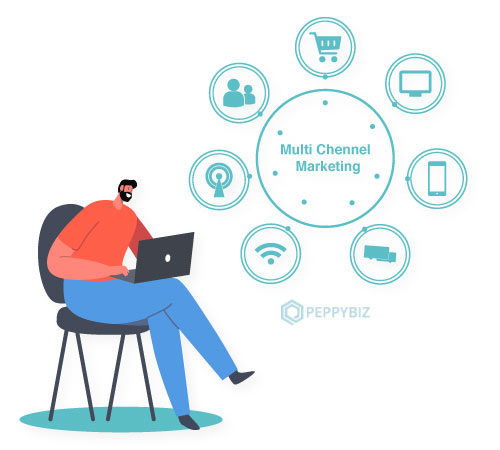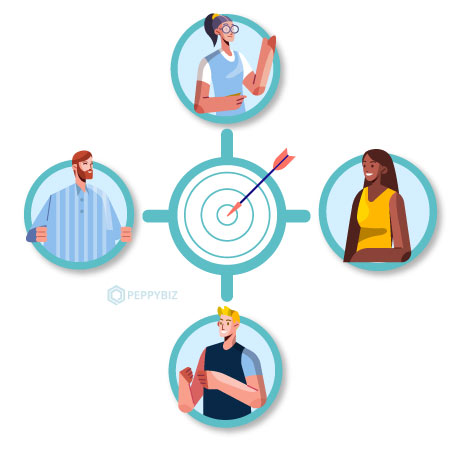Multi-Channel Marketing 101 Guide | Everything You Need To Know As Beginner
In today’s competitive world of marketing, various channels are being explored. With numerous options available, your potential customers can be anywhere. With marketing channels growing every day, businesses must gear up for multi-channel marketing.
If you keep pace with technology and trends, you will know how technology and social media have impacted businesses. Customers have the levy to know all about a brand, check the trends, and then decide. Companies that fail to adopt new measures will become extinct in the future.
In this blog, we will understand what multi-channel marketing is. We will also develop strategies for beginners which can be adopted in growing businesses.
What is Multi-Channel Marketing?

Multi-channel marketing means interacting with customers or marketing your product on multiple platforms, both offline and online. It includes all communication channels like websites, mail catalogs, emails, social media, mobiles, and even retail stores.
Cross-channel marketing gives customers a levy to communicate on different channels they are comfortable with. In today’s world, businesses have to find potential customers. Gone are the days when customers had to look for products.
As aspiring companies and entrepreneurs, you have to keep all communication channels open for customers. Cross-channel marketing comes into play to this feat.
Importance of Multi-channel Marketing
If you are focusing on a single channel to get customers, you may lose the battle. In the interest of your business, you will have to get into all available channels to get potential customers.
As we are aware, there are numerous devices available. There is a TV, a mobile device, and a laptop. That’s not all; every user is hooked to at least four to five media channels. Even if we talk of choices, there are numerous choices for any customer today.
As marketing channels are growing, having a well-established multi-channel marketing plan will be the key. Customers are researching different media before executing a purchase. In addition, multi-channel users spend two to three times more than average customers. Therefore, businesses must target all these channels to find potential customers.
Coordinating Cross-channel marketing

As marketing channels are growing day by day, you need a management console. Making use of technology will bind all channels into a single platform. The success in multi-channel marketing depends on creating cohesion between different media. In addition, marketers will have to adopt the correct marketing strategies.
A majority of customers prefer an integrated marketing approach. However, businesses are hesitant due to management issues. So, how do we coordinate cross-channel marketing?
Here are three steps that beginners should follow.
- Use technology to create a single platform of customers across different channels.
- Be consistent in verifying customer experience across different channels.
- Unify your customer data in a single platform and analyze different platforms.
Strategies for Beginners
Building a successful multi-channel marketing strategy begins by understanding its complexities. You must be aware of the limitations and ways to integrate different channels. Here are some proven strategies for upcoming businesses.
1. Identify your customers

Focusing on potential buyers is necessary; it begins with defining a buyer’s persona over multiple channels. Then, information about your customers will help you decide on the media that needs focus.
The identity of multiple channels cannot be developed overnight. It will take time and effort and considerable experience to get there. In addition, there will be customers showing dynamic shifts in various platforms. So your aim should be first to identify customers and then sort them as per the marketing channels.
2. Target selected channels
Targeting every channel may not prove an effective multi-channel marketing strategy. It will not be cost-effective and pose inherent management issues. Instead, do a little research and make a list of potential channels. Now target these channels according to your customer persona.
Your goals and business profile are also important while deciding on channels. Even when some channels may not be popular may offer more customers to your business. In addition, as a beginner, don’t lose focus on lesser popular media. The more you experiment, the more chances to get an opening for potential customers.
3. Cohesive Experience
There will be different members specialized for other channels. But, as a beginner in multi-channel marketing, you must have the cohesive experience to reduce cost. In addition, it will prevent your audience from switching from one platform to another, creating confusion for you.
Businesses must ensure the entire team is in sync and understands the focus area. They need to have unified messaging to target the audience. In addition, have a system of sharing information and experience within your marketing group.
4. Automation is critical
No one can deny the fact that businesses need automation to grow. Brands that are targeting multi-channel marketing should automate their process. Marketing automation will solve many issues related to management and analysis.
A CRM paired with a database management system will provide detailed insight. It will give you several CTAs, traffic details, and emails open across different channels. It will help course correction and diverting focus as per the performance on various channels.
5. Don’t Ignore your website
Your website is your show window and should not be neglected. Give your customers multiple devices and different channels to reach your website. All these channels must link to your website with the appropriate CTA. It gives you uniform access to manage customers and an opportunity to showcase all that you have.
6. Focus on Retargeting

Retargeting relinks to traffic that has bounced back. It is important to convince customers about your product and take them back into the loop. At times customers leave the platform due to other disturbances. As a beginner, you will have to chase them.
In marketing, retargeting is important to increase your traffic. Retargeting gives your potential customers a relook at your website or product. In addition, it is a proven strategy that is used by many successful businesses.
7. Abide by rules
Keep your messaging consistent and keep track of all channels. Channels like Instagram will be effective with visual posts; follow it. If you have a video, upload it on YouTube. Longform content and data will work best on LinkedIn and your website blogs.
The rule will be to design different strategies for different platforms. Even if your message and content are the same, you will have to modify the content for other channels.
Challenges in multi-channel marketing
Having seen the strategies and importance of multi-channel marketing, we look at the challenges. For beginners, knowing the difficulties is important to overcome them.
1. A Specific Channel May Suit your Business
A particular channel may be suitable for your business, but you will lose the opportunity on other media. In addition, there is a risk of missing out on funneling customers to one particular channel.
For example, a marketer with good communication skills may not influence customers with social media marketing. Likewise, your salesman can be effective for telemarketing but will fail to influence online customers.
2. Management Issues

Managing multiple channels will always be difficult with limited time. At times you will be overwhelmed managing your time and business. In addition, it will also require promotion on different channels, framing different strategies, and integrated marketing.
3. Increased Expenses

Managing across various channels will require an extra budget. Not only do you need more time but more energy and money to operate across different channels. In addition, you will have to hire additional staff and plan for automation.
Conclusion
Multi-channel marketing is all about promoting your business across various channels. It gives your brand increased access to potential customers. In today’s marketing era, there are different channels open to reach potential customers.
In a nutshell, beginners must enhance their avenues by the consumer-first policy. Begin with selected channels and gradually explore more avenues. In addition, growing businesses need to prepare for unexpected challenges.
FAQ
1. Which marketing channels to be used together?
It depends and varies according to different businesses. The best solution is to target offline and online models together. The important point is to try various channels and then see what works best for your business. There are different channels for B2B, SaaS and also depend on the products you offer.
2. How should we measure multi-channel efforts?
There are various ways to measure your efforts. The best will be a credit model that evaluates click rates and the number of visitors on each channel. Most companies are also adopting evaluation models based on previous sales results. In addition, companies must set a benchmark and then measure it, keeping those benchmarks in mind. Benchmarking will also give an analysis of your monthly progress.
3. How to integrate the experience across channels?
Use automation and CRM to integrate the experience across channels. You can also use a unified inbox to keep track of customer communication across various channels. In addition, the use of a marketing management system will integrate your experience across channels.

